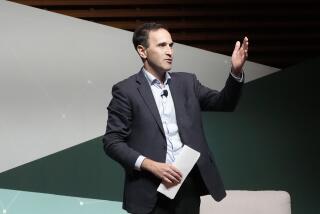Hospitals Call Mortality-Rate Study Misleading : Daniel Freeman Most Vocal, but All Say Statistics Don’t Paint True Picture
- Share via
When a consumer watchdog group recently released a report on the death rates of Medicare patients in California hospitals, the numbers showed that Daniel Freeman Memorial Hospital in Inglewood had a 21.1% death rate--nearly three times the state average--for a specific group of 71 patients undergoing heart-bypass surgery.
“If you look at these statistics, it looks as if one out of every five who have surgery at Daniel Freeman dies, and this is wrong,” complained spokeswoman Christie Ciraulo, adding that the hospital is regarded as a leader in cardiology.
According to the hospital, what the raw numbers do not explain is that the people in the group surveyed were acutely ill and in the midst of heart attacks or heart failure when they arrived at the hospital as emergency cases. For patients who have elective bypass surgery, she said, the death rate is less than 6%.
Release of the information by California Medical Review Inc., a group established under federal regulations to review the Medicare health insurance program for the elderly and disabled, was accompanied by a number of cautionary statements.
Age Not Considered
For example, it was noted that the reports covered only the 50 most common of the 479 Medicare patient diagnostic categories and that the information should not be used to judge hospital quality without considering such factors as patient age and the severity of illnesses.
But Ciraulo said that when the public--including those who will go to a hospital at some point in their lives--sees such numbers, the figures make more of an impression than the cautions that accompany them--especially when they are printed in charts in newspapers.
Officials at other South Bay hospitals named in the report agreed that the numbers do not tell a fair story about the hospitals, although they were less vocal than Daniel Freeman.
“It’s very possible that some people might not come to Daniel Freeman based on these statistics, and those that do so may be suffering from fears that they don’t need to suffer from,” Ciraulo said.
She was critical not only of the numbers cited in the report, but also asked why they were released by the review organization if, as the group said, the numbers do not necessarily indicate poor performance but are intended as a starting point for consumers to ask questions.
“People should question hospitals and doctors, but the figures do not have meanings,” she asserted. “What’s the point of listing percentages if CMRI says don’t pick hospitals based on numbers?”
Torrance Memorial Hospital was listed in the report as having above-average death rates for pneumonia--23.3% as compared to the average of 12.3%--and 10.9% for heart-bypass surgery.
‘Confusing’ Report
In a prepared statement after press accounts of the report, Torrance Memorial President George W. Graham called the report “very confusing” because it did not consider such things as severity of illness and age of patients.
He said that of the 51 deaths represented by the 23.3% pneumo nia figure, 28 were 80 years of age or older and nine of those were 90 or older. In addition, he said, 67% had other serious health problems.
In March, Torrance commented in writing to the organization while the report was being drafted. At that time, Torrance said “the statistics might be subject to misinterpretation.”
Torrance officials declined to discuss what effect the review might have on the hospital’s image or how it might influence people choosing a hospital.
Analysis Necessary
South Bay Hospital in Redondo Beach, which was above the state average in heart attack deaths, was critical of the report but less concerned about the fallout than Daniel Freeman.
“Consumers have a right to all information, but beyond that, the information needs to be analyzed,” said Susan Pearson, who reviews insurance matters, including Medicare, for the hospital. “The difficulty with the CMRI data is that it does not include analysis. You have to look at issues on a case-by-case basis to make a meaningful judgment.”
She said that almost every heart attack case involving elderly Medicare patients is accompanied by “coexisting factors,” including coronary artery disease and hypertension.
“In many cases, it is the patient’s second or third heart attack,” she said.
No Damage Expected
At the same time, however, she said South Bay Hospital will not be damaged by the report, which showed a 29.6% death rate for 91 heart attack patients. The state average was 20.4%.
“This is a relatively well-educated community, these are aware and thinking people,” she said. “I’m comfortable there has been a good quality of care and that people will ask questions. They won’t judge the hospital on a number.”
Harbor-UCLA Medical Center in Torrance had a 32.4% death rate of the 70 patients with the kind of heart attacks monitored in the study.
The medical review statistics cover about 1 million Medicare hospitalizations in California for a two-year period ending in September, 1986.
Publication Praised
Some consumer groups and some health-care experts praised publication of the information, saying it might lead to improved health care.
“I feel consumers deserve information about hospitals, and if mortality rates are an indicator of quality, I would want people to know the mortality,” said Cathy Michaelson of the National Council on Aging, an organization of professionals in the field of aging. At the same time, she said she understands hospital concerns that these statistics could be misconstrued.
But, she said consumers are discerning enough to look beyond the numbers. “They have common sense and will look to ask more questions,” she said, adding that people tend to go to hospitals their doctors suggest. “They will ask their doctors about mortality rates and expect to have it explained,” she said.
The mortality statistics already have achieved their purpose because people are asking questions about them, said Lucia Divenere, a health policy specialist with the National Council of Senior Citizens, an advocacy group. “From the senior point of view, people operate from a vacuum of information, so any data is helpful,” she said. “It opens the door.”
Some Adverse Reactions
She agreed with critics that some consumers might look at the numbers and say, “Oh, my God, I’m never sending anyone to that hospital again.” But she said others are more sophisticated and would get more information.
However, the Hospital Council of Southern California contends the numbers are useless, said David Langness, vice president for communications.
“They are solely numbers, and they give no indication whatsoever of the severity of illness, age, or any other fact that bears on the reasons why patients die.”
He said that because physicians and surgeons practice at several hospitals, patient mortality gauged to physicians, and not hospitals, would be a more useful measure. But he said such a measure would invite lawsuits based on confidentiality protections.
Statistics ‘Skewed’
At Daniel Freeman, chief cardiologist Dr. Robert Chesne said the heart-bypass surgery death rate is “skewed” because of Freeman’s admission and medical policies. He said that while mortality rates for other hospitals include less risky elective surgeries of hospitalized patients, Daniel Freeman’s numbers apply largely to outpatient emergency cases. He also said that in place of open-heart surgery, the hospital makes extensive use of a balloon device that is inserted to expand impaired arteries. Surgery, he said, tends to be performed only on the sickest people.
“We are noted for cardiology,” he said. “Other hospitals send their sickest people to us.”
More to Read
Sign up for Essential California
The most important California stories and recommendations in your inbox every morning.
You may occasionally receive promotional content from the Los Angeles Times.










